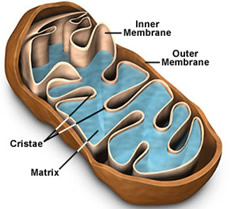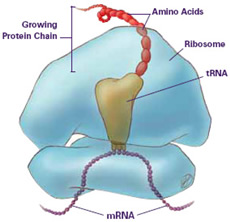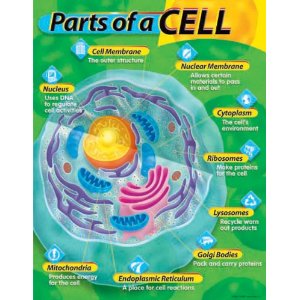 |
| Plant cell |
The cytoplasmis defined as all of the living matter within the plasma membrane of a cell, except for the nucleus, which is isolated from the cytoplasm by the nuclear envelope.
The cytoplasm, bounded by the plasma membrane, is composed of fluid called the cytosol in which floats a large variety of molecules and molecular assemblages, ribosomes (responsible for polypeptide synthesis), and a variety of other structures called organelles (literally meaning “little organs”).
Numerous biochemical processes occur in the cytosol, including protein synthesis (translation) and glycolysis.
  |
Vacuoles
The vacuole is the largest, most noticeable, organelle in plant cells (up to 40 micrometers in length). Vacuoles are membrane-bound sacs that can occupy up to 90 percent of the plant’s cell volume.
The vacuole serves a wide range of purposes, depending on the cell type. It is filled with water and a variety of salts, sugars, organic acids, pigments, or proteins.
 |
| Vacuoles |
The vacuoles of flower petal cells contain blue, red, or pink water-soluble pigments. In other cells, the vacuole is full of toxic compounds that deter insect attack. Vacuoles in seed cells contain storage proteins that are remobilized during seed germination and used for early seedling growth.
Plastids
Plastids are the next largest easily observable organelle (5 to 10micrometers in diameter). Plastids are surrounded by a double membrane and are involved in a variety of biosynthetic reactions in the plant cell.
All plastids start as immature proplastids in meristematic (young and undifferentiated) cells. Then, depending upon which tissue type grows from that meristem, proplastids may develop into one of several different mature plastid types.
The most prominent type of plastid is the chloroplast, contained primarily in leaf cells. Chloroplasts are colored by the green pigment chlorophyll. They are the site of photosynthesis and a number of other biosynthetic reactions.
Chromoplasts are red, orange, or yellow, as a result of their high levels of carotenoids. They are found in the petals of flowers, old leaves, some fruits, and even in some roots, such as the carrot.
Leucoplasts are a nonspecific group of plastids named for their lack of pigments (the prefix leuco means “white”). They include amyloplasts, which synthesize and store starch, such as in potatoes, and a variety of other plastids specialized for synthesis of oils, proteins, and other products.
Amyloplasts are also found in the cells of the root cap, where they are involved in gravity sensing, or geotropism, by the root tips. Plastids divide by fission, and there may be ten to one hundred per cell.
Mitochondria
 |
| Mitochondria |
The outermost of the two membranes controls transport of molecules into and out of the mitochondrion. The inner membrane is the site of the electron transport chain and oxidative phosphorylation, two components of respiration.
The aqueous space bounded by the inner membrane is the site of the Krebs cycle. Like chloroplasts, mitochondria divide by fission, and there may be ten to one hundred mitochondria per cell, depending upon cell type.
Microbodies
Small (0.5 to 1.5 micrometers in diameter) organelles called peroxisomes are bounded by a single membrane. Some peroxisomes contain the enzymes involved in the recycling and detoxification of the products of photorespiration.
Glyoxysomes, another type of peroxisome, are found in germinating seeds. They contain the enzymes involved in the conversion of fats to sugars during the mobilization of storage lipids.
Endomembrane System
The endoplasmic reticulumis a series of connected tubules that traverses the cytosol and is the largest member of the endomembrane system. The interior of the tubules is called the lumen. Rough endoplasmic reticulum (RER) is studded with ribosomes, while smooth endoplasmic reticulum (SER) is bare.
Proteins synthesized on the ribosomes of the RER are inserted into the lumen during synthesis, where they are delivered to the Golgi complex for processing. The SER is typically where lipids are made but is rarely seen in plant cells because plastids perform most of the lipid synthesis in plants.
The Golgi complex is a series of stacked membranes that process and package proteins or polysaccharides for transport within or secretion out of the cell. Individual units are called Golgi bodies or dictyosomes, while collectively they are referred to as the Golgi complex. The endomembrane system gets its name from the fact that many of its components are connected in various ways.
Ribosomes
 |
| Ribosomes |
Ribosomes are the sites of protein synthesis. All proteins are large strings of amino acids bonded end-to-end. During protein synthesis, a strand of messenger RNA (mRNA) from the nucleus travels to the cytoplasm, and one end binds to a ribosome.
The ribosome travels down the mRNA and “reads” the genetic information contained on it. The ribosome then “translates” that genetic information into a protein by stringing amino acids together, one at a time, in accordance with the information on the mRNA.
Some ribosomes float freely in the cytosol, and others are bound to the endoplasmic reticulum, which is then called “rough ER” because of its appearance under the electron microscope. Proteins made on free ribosomes are released into the cytosol. Proteins made on ribosomes bound to rough endoplasmic reticulum cross the ER membrane and are released into the lumen of the ER for further processing and transport.
Cytoskeleton
All plant cells are surrounded by a cell wall. However, the cytoplasm itself is further structured and organized by components of the cytoskeleton. The three major components of the cytoskeleton are microtubules, intermediate filaments, and microfilaments.
Microtubules are hollow tubes 24 nanometers in diameter, made of individual, repeating subunits of the protein tubulin.
They are involved in positioning and moving the chromosomes during mitosis and meiosis, in directing the laying down of cellulose strands during cell wall formation, and in determining where a new cell plate will form during cell division (that is, cytokinesis). Microtubules do not work alone, and numerous microtubule associated proteins have been identified.
Intermediate filaments are a broad class of cytoskeletal components, and each type is composed of different proteins. They are all solid rods 8-12 nanometers in diameter.
 |
| part of a cell |
Microfilaments are thin filaments (7-8 nanometers in diameter) made up of individual, repeating subunits of the protein actin. Microfilaments are involved in moving cellular organelles, such as plastids and mitochondria, around the plant cell and, like microtubules, interact with a variety of other proteins, especially myosin.
In fact, the actin and myosin interaction is so well documented that many researchers refer to them together by simply calling them actinomyosin.